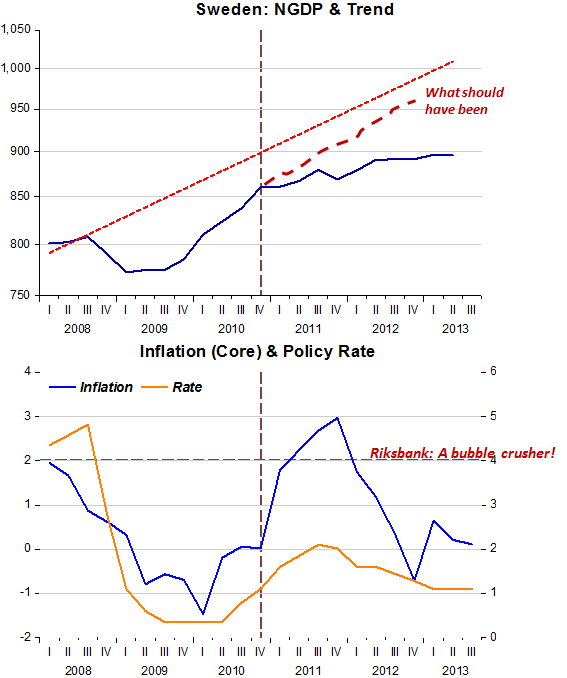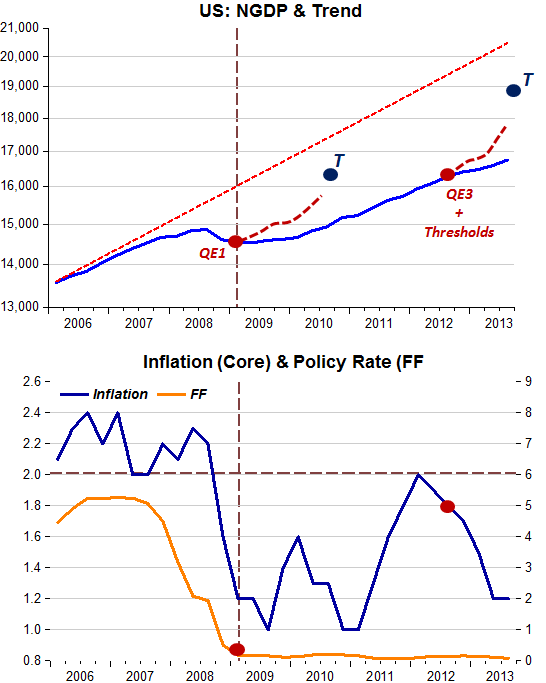And in one country, Sweden, the independent central bank has kept interest rates above the ZLB, even though prices have been literally falling. While the central bank cut short rates to 0.25 in 2009, during 2010 they were increased to 1%, and during 2011 to 2%. They have since been cut to 1%, but the central bank does not want to cut any further despite prices being flat or falling throughout 2013. Yet the central bank has a clear target for inflation of 2%.
The reason the Swedish central bank – the Riksbank – is overriding its inflation target were clearly set out in a speech given by Kerstin af Jochnick, First Deputy Governor of the Sveriges Riksbank, in January 2013. The Riksbank is concerned that low interest rates will exacerbate a housing bubble. The discussion is interesting for at least two reasons. The first is that the Riksbank is not primarily concerned about the impact of any bursting bubble on the financial sector itself. It is not worried about a second financial crisis. Instead it is worried about the impact a bursting bubble might have on households (creating another balance sheet recession) and overseas confidence.
The Riksbank raised rates sharply even though inflation was below target and falling, and has only partially reversed the move even though the country is now flirting with Japanese-style deflation. Why? Because it fears a housing bubble.
This kind of fits the H.L. Mencken definition of Puritanism: “The haunting fear that someone, somewhere, may be happy.” But here’s the thing: if we really are in the Summers/Krugman/Hansen world of secular stagnation, things like this are going to happen all the time. The underlying deficiency of demand will call for pedal-to-the-medal monetary policy as a norm. But bubbles will happen — and central bankers, always looking for reasons to snatch away punch bowls, will use them as excuses to tighten.
But has the US acted any different (as a practical matter)? For example, Gavyn Davis writes: “The separation principle drives the Fed towards tapering”:
…These personnel changes will create their own uncertainty. But, in addition, the Fed’s monetary strategy is clearly in a state of flux, with its approach to tapering having developed markedly in recent weeks. A new “separation principle” seems to be emerging, and it explains why the FOMC seems eager to begin winding down its asset purchases in the near future, while relying even more heavily than before on “lower for longer” guidance on forward short rates. This could have important ramifications for markets.
… Furthermore, Fed Governor Jeremy Stein has argued that asset purchases might well cause more distortions to asset prices via the reach for yield than the distortions which are caused by lower short rates. With the benefits of asset purchases in terms of economic activity being less, and the costs in terms of market bubbles being greater, it is not surprising that the Fed is opting increasingly for the forward short rate weapon.
Even if ‘procedures’ are different in the two countries, the ‘background noise’ is the same: A fear of bubbles!
It´s not surprising that the outcomes have been similar as the set of charts for both Sweden and the US illustrate.


Note that up to end 2010 Sweden was performing better than most, with NGDP on the route back to trend. But ‘bubble fear’ butted in!
In the US, QE1 was only enough to stop the fall in NGDP. QE3 plus thresholds has clearly not been effective (in a positive sense, not just as relative to a counterfactual). NGDP growth has flattened a bit over the past year and inflation has fallen significantly.
In the US related charts “T” stands for a level target for NGDP. What if instead of “targeting instrument settings” the Fed had targeted a level of NGDP? That´s the counterfactual I prefer.





Be the first to comment on "All central banks, in practice, are acting alike!"